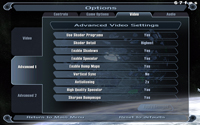Prey
Publisher: 2K GamesWe used the full retail version of Prey, patched to version 1.3. The game, developed by Humanhead Studios, is based on an enhanced version of the Doom 3 engine. It features many unique gameplay features including gravity flipping and gravity walking -- these allow you to walk on walls or ceilings, making for some very interesting gameplay. Because of these features, it's very easy to get disorientated whilst playing Prey on a big screen.
On the graphics front, the engine is based on OpenGL and supports bump mapping, dynamic shadowing, glow effects, particle effects, specular lighting, skinning and high-quality textures. Although the Doom 3 engine is almost three years old, it still looks pretty stunning -- that's a testament to how well the Doom 3 engine has aged.
For our testing, we used a demo from the Salvage level, which incorporates all of the effects we've discussed above. Based on our experiences, we found that the Salvage level was the most intense level in the game, so it should serve well as a 'worst case' scenario in this title.
We set the in-game quality settings to their highest selectable options, leaving vsync disabled. Anti-aliasing and anisotropic filtering were controlled inside the game via the command line, but there is the option to select them in the game's display options menus.
Prey is a title where, without anti-aliasing, the HIS Radeon HD 2600 XT IceQ Turbo GDDR3 performs incredibly well - it's about as fast as the previous generation and is much faster than Nvidia's GeForce 8600 GT and GeForce 8600 GTS cards. However, RV630 unfortunately suffers from the lack of a fixed-function MSAA resolve unit and, as a result, you'll see a massive performance hit - as much as 69 percent in this particular title - when anti-aliasing is enabled (to any degree).

MSI MPG Velox 100R Chassis Review
October 14 2021 | 15:04












Want to comment? Please log in.